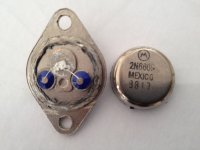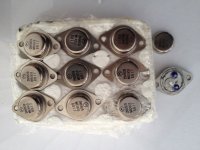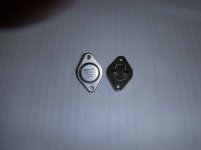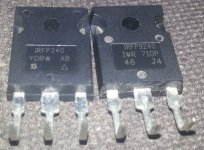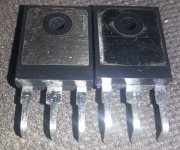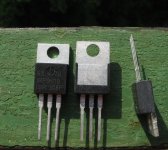BeO was rare even 40 years ago before the health and safety became strict and only common in RF power devices as a solid block. This solid is safe enough unless you file itDo people also be carefull when open these transtistors? it can contain Beryllium oxide, and is is very dangerous.
Most is afcourse found in HF transistors but a warning is on his place here, special when fakes.
Hello
This transistor is original and was produced by MEV Hungary.This factory does not exist in 1986 when the fst factory destroyed by fire and was not restarted again.
This transistor is original and was produced by MEV Hungary.This factory does not exist in 1986 when the fst factory destroyed by fire and was not restarted again.
Hi.
Thanks for the information.
The photo of the 2N3055 on the ESP website is identical to mine.
MEV History
Andy
Thanks for the information.
The photo of the 2N3055 on the ESP website is identical to mine.
MEV History
Andy
Hi There
On forums in Hungary can buy the remaining stocks Mev. I used these products and are very ok, but beware high as already occurred with company logo MEV products in China !!
On forums in Hungary can buy the remaining stocks Mev. I used these products and are very ok, but beware high as already occurred with company logo MEV products in China !!
Hey Andy,
How many did you buy? Personally, I have never seen any semiconductors without date codes or run numbers. I wouldn't use them in anything I don't want to see sparks or flame come out of.
They just might be fine, but with no way to track lot numbers, what is the factory QC like? Or ... do the parts get that stuff marked on after they pass QC (rejects?). Highly suspect!
-Chris
How many did you buy? Personally, I have never seen any semiconductors without date codes or run numbers. I wouldn't use them in anything I don't want to see sparks or flame come out of.
They just might be fine, but with no way to track lot numbers, what is the factory QC like? Or ... do the parts get that stuff marked on after they pass QC (rejects?). Highly suspect!
-Chris
The photo on the website mentioned has no date codes !!
( Also the factory is no longer there and was only in production for a short time.)
How many -- a few !!
Andy
( Also the factory is no longer there and was only in production for a short time.)
How many -- a few !!
Andy
Fakes from HKpartspipe2012
I also just took a chance buying some 2N6609s from the EBAY seller HKPartspipe2012.
All fakes !!!!!
Die too small.
Printing all over the place.
I am waiting for a reply to my request for an immediate refund before posting Bad feedback.
Andy
I also just took a chance buying some 2N6609s from the EBAY seller HKPartspipe2012.
All fakes !!!!!
Die too small.
Printing all over the place.
I am waiting for a reply to my request for an immediate refund before posting Bad feedback.
Andy
Attachments
Hi Woody,
Yours are either Motorola or On Semi. I guess Toshiba uses a similar base, but it feels like On Semi parts.
Bad is bad. Future bad is worse 'cause it takes other things out with them. Try to shop proper distribution if you can.
Hi Andy,
Never seen the Motorola bat inside a circle before. I guess you would have to order one or two of everything you were interested in. Stuff that passes can be ordered in larger quantities. I would use capacitance as your non-destructive test for incoming QC after the first destructive tests. Add these steps to your actual cost before accepting the price as listed. Eventually you will find a dealer or two you can trust (I hope). They get ripped off too.
-Chris
Yours are either Motorola or On Semi. I guess Toshiba uses a similar base, but it feels like On Semi parts.
Bad is bad. Future bad is worse 'cause it takes other things out with them. Try to shop proper distribution if you can.
Hi Andy,
Never seen the Motorola bat inside a circle before. I guess you would have to order one or two of everything you were interested in. Stuff that passes can be ordered in larger quantities. I would use capacitance as your non-destructive test for incoming QC after the first destructive tests. Add these steps to your actual cost before accepting the price as listed. Eventually you will find a dealer or two you can trust (I hope). They get ripped off too.
-Chris
The Motorola "M" inside the circle was common from the late 80's after they switched from the aluminum to the steel TO-3, up until they became "ON". Unfortunately, the "M" isn't drawn correctly. The only 'real' 2N6609's you're ever going to find anymore are marked 'MJ15004' or 'MJE4353'. Same die, tested to different spec, and the MJE is in a TO-247. Ever notice that the datasheet curves are identical? This goes for a lot of their devices - there really isn't as much variety as you might think. If you wanted guaranteed, tested 150W @100V SOA you'll have to step up to the MJ2119x. In many cases you don't need to. If you found some old aluminum 6609's, they're probably not fakes but they're more likely to show up on Antiques Roadshow than on E-bay.
Hi wg_ski,
Thanks for that. Maybe that is why they just looked different / unfamiliar to me.
MJ15015/15016 (complete junk) close to MJ15022/MJ15023 or MJ15024/MJ15025 (excellent parts). Those had completely different mamas! 🙂 Reading the part description can also tell you a lot about a device. The first pair (MJ15015/MJ15016) are classed as "economy transistors". Translate that to "Don't use these" 🙂
The MJ2119x parts are very good in other ways that make them a good choice to use. The pair I really like may not be available now, they were the MJW0281A and MJW0302A. I would use those exclusively within their voltage breakdown limitations. Their secret? The Hfe is almost perfectly matched within the part #, and also across to the complimentary parts. Output matching can reduce distortion by a decade (before feedback). That is more than worthwhile.
Suffice to say, I am an On Semi fan. For their non-economy graded parts!
-Chris
Thanks for that. Maybe that is why they just looked different / unfamiliar to me.
Yes, absolutely. Now that paper data books are no longer available, it is far more difficult to find these instances. Current data books are something I always had (until we can't get new ones anymore). I even buy old data books simply because that is the only way to declare a component good or bad (at close examinations) or find a real substitute that works well.Ever notice that the datasheet curves are identical? This goes for a lot of their devices - there really isn't as much variety as you might think.
MJ15015/15016 (complete junk) close to MJ15022/MJ15023 or MJ15024/MJ15025 (excellent parts). Those had completely different mamas! 🙂 Reading the part description can also tell you a lot about a device. The first pair (MJ15015/MJ15016) are classed as "economy transistors". Translate that to "Don't use these" 🙂
The MJ2119x parts are very good in other ways that make them a good choice to use. The pair I really like may not be available now, they were the MJW0281A and MJW0302A. I would use those exclusively within their voltage breakdown limitations. Their secret? The Hfe is almost perfectly matched within the part #, and also across to the complimentary parts. Output matching can reduce distortion by a decade (before feedback). That is more than worthwhile.
Suffice to say, I am an On Semi fan. For their non-economy graded parts!
-Chris
Hi wg_ski,
The first pair (MJ15015/MJ15016) are classed as "economy transistors". Translate that to "Don't use these" 🙂
15015 is actually a variant of the 2N3055. The hFE curves are identical. The die is the same layout, just stretched in one direction to get higher Pdiss. The beta is still under 10 at 15A, which sucks for sure. Parallel enough of them and your drivers might survive 🙂 I've used plenty of these and other 'economy' parts over the years - you just can't expect miracles with them.
I had a batch of fake MJ15024's I got once. All marked identically, some early 90's date code. The first clue I had to them being fakes was the bias not sharing properly - it varied between a couple mA and 50mA in a parallel bank. The same batch NEVER does this, even if you don't bother to match Vbe. Solderability of the leads was pretty poor, too. The amplifier did work (it was an S-Leach type output stage, would have survived with 3055's). But I pulled them out and put in a fresh batch. The bias was spot on. Pulled the covers to see what was inside - and of course the tops popped off way too easy. Some of them were these little bitty dies you usually see. One WAS and MJ15024 die, but covered in silicone. Two were MJ15003/2N3773/2N5631 dies, and no silicone. They all had a heat spreader, but the dies were all oriented straight up and down - real ON/Moto's are oriented at 45 degrees. The ones with the better dies might have been rejects or 3rd party copies, no way to tell. But they all came off the same packaging line - somewhere in China. I guess they will stick in anything they can get cheap.
Last edited:
looking for a transistor for 1 watt fm exiter its an old trannie.. it must have a new model number or a simular model it is a.TRW PT8860 iff any 1 knows of a new kind please let me no
REGARDS phil//
REGARDS phil//
you might reach a wider audience if you started a new Thread with the device and it's duty in the Thread Title.
I have some IRFP240 and IRFP9240 like these image. IRFP240 look like Vishay brand and IRFP9240 look like IR brand. I got them from a diy dealer in my country.
Do anybody can indentify if they are original or couterfiet?
Do anybody can indentify if they are original or couterfiet?
Attachments
IRF9610
I bought these on ebay from jk_parts:
10 x IRF9610 IRF 9610 Power MOSFET to 220 | eBay
The fets look like cheap fake, but I'm not 100% sure.
The leads are 0.3mm!!! thick (side view).
I bought these on ebay from jk_parts:
10 x IRF9610 IRF 9610 Power MOSFET to 220 | eBay
The fets look like cheap fake, but I'm not 100% sure.
The leads are 0.3mm!!! thick (side view).
Attachments
Hi,
This thread was originally started to give other folks the tools to figure this out by themselves. If you read near the beginning of the thread you can see where we were measuring the capacitance of the device to see if it was in the normal range for that type of part. Also, examination of the case style and leads is really your first step in figuring this stuff out.
Please attempt to learn new things and try to use previous information before simply posting the parts and asking the question. It is perfectly okay to post pictures after you have figured this out in order to warn other folks.
-Chris
This thread was originally started to give other folks the tools to figure this out by themselves. If you read near the beginning of the thread you can see where we were measuring the capacitance of the device to see if it was in the normal range for that type of part. Also, examination of the case style and leads is really your first step in figuring this stuff out.
Please attempt to learn new things and try to use previous information before simply posting the parts and asking the question. It is perfectly okay to post pictures after you have figured this out in order to warn other folks.
-Chris
- Home
- Design & Build
- Parts
- My Transistors, original or copy?
 )
)